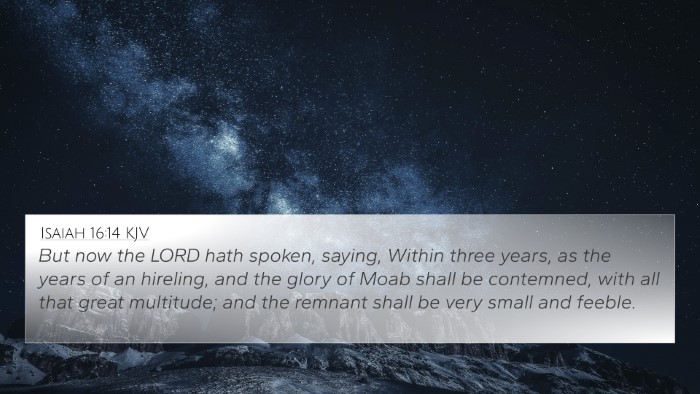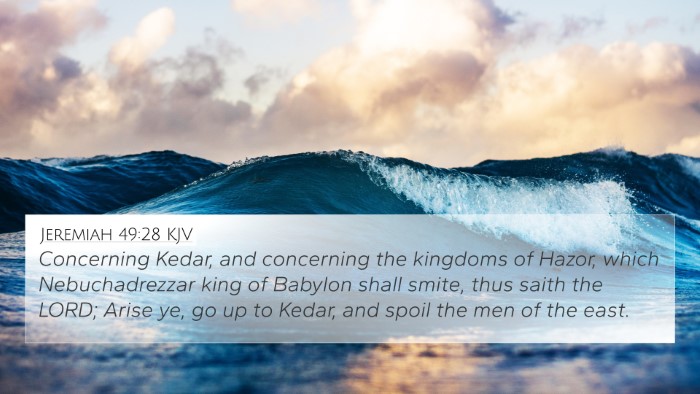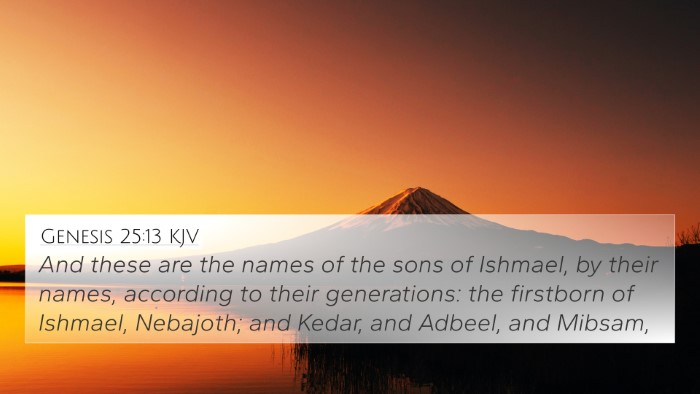Understanding Isaiah 21:16
Isaiah 21:16 states: "For thus hath the Lord said unto me, Within a year, according to the years of an hireling, and all the glory of Kedar shall fail." This verse reflects God's declaration regarding the impending decline of the glory of Kedar in a specific timeframe.
Meaning and Interpretation
The message delivered by the prophet Isaiah here includes significant insights found in public domain commentaries:
-
Matthew Henry:
Henry interprets this verse as a pronouncement of judgment on the people of Kedar, emphasizing the transient nature of earthly glory and the assurance that God’s word will come to pass. He elucidates how this is part of God's broader plan against nations that have opposed Israel.
-
Albert Barnes:
Barnes notes that the period mentioned—“within a year”—is critical. It speaks to the swiftness of divine judgment. He insists that the glory of Kedar, representative of the Arabians, would swiftly dissipate, reinforcing the theological point that human strength is ultimately under God's control.
-
Adam Clarke:
Clarke elaborates on the geographical and cultural significance of Kedar, viewing it as a symbol for those who are prosperous but do not acknowledge the true God. He asserts that the decline of Kedar serves as a warning to all nations regarding the consequences of pride and rebellion against God.
Cross-References and Thematic Connections
This verse connects with several other Bible verses, highlighting the themes of divine judgment and the fate of nations:
- Isaiah 13:19-22: Prophesies the destruction of Babylon and its glory, similar to the fate of Kedar.
- Jeremiah 49:28-29: Discusses God's judgment against Kedar and other Arabian nations.
- Ezekiel 30:17: Speaks of the fall of Egypt, resonating with the message of vulnerable pride.
- Psalms 89:44: Reflects on the diminishing of glory and power, tying back to the transitory nature of human achievements.
- Lamentations 2:5: Describes how God has become an enemy to His people, showcasing the theme of divine retribution.
- Isaiah 42:24: Mentions how God’s people are given over to their oppressors, linking to the consequences faced by rebellious nations.
- Matthew 24:2: Jesus speaks of the temple’s glory being dismantled, mirroring how transient human structures can be.
Connections Between Bible Verses
The relationships among these verses depict a multifaceted tapestry of divine judgment and the ephemeral nature of human glory. Analyzing these scriptures can yield profound insights into God's sovereignty over the nations and the assurance that His prophecies are fulfilled in accordance with His divine timetable.
Comparative Study and Cross-Referencing Tools
For those interested in deeper study, considering tools for Bible cross-referencing is essential:
- Bible concordance: A comprehensive guide to locate words and their occurrences throughout scripture.
- Cross-reference Bible study materials: Resources that help bridge connections between different biblical texts.
- How to use Bible cross-references: A method that aids in examining similarities and themes across various scriptures.
- Inter-Biblical dialogue: Engaging with the discussions that arise when different biblical texts speak to one another.
Practical Application in Bible Study
Understanding Isaiah 21:16 and its connections encourages a comprehensive approach to scripture; it can be beneficial for sermon preparation, personal study, and teaching.
By employing cross-referencing methods, you can explore thematic Bible verse connections, discovering deeper meanings and applications relevant to life's challenges and spiritual journeys.
Thematic Reflections
Isaiah 21:16 serves as a poignant reminder of the need for humility in acknowledging God's ultimate authority over all creation. As we navigate through life and its complexities, reflecting on the fate of Kedar encourages believers to seek God's favor above earthly accolades.
By engaging with this verse, we open ourselves to the broader narrative woven throughout scripture, fostering a richer understanding of faith and its implications in our daily lives.












